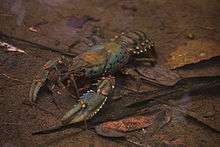Kidston Dam
Kidston Dam also known as Copperfield Dam is a dam in Lyndhurst, Shire of Etheridge, Queensland, Australia.[1] It is approximately 200 kilometres (120 mi) north of Hughenden and was built for the Kidston Gold Mine. The mine closed July 2001. The lake created by the dam has a capacity of 20,400 megalitres (720×106 cu ft).[2]
| Kidston Dam | |
|---|---|
| Location | Lyndhurst, Shire of Etheridge, Queensland, Australia |
| Coordinates | 19.0354°S 144.1235°E |
| Type | reservoir |
| Basin countries | Australia |
History
This storage and associated pipeline was built to provide water to the Kidston Goldmine in the early 1980s on the Copperfield River, a tributary of the Einasleigh River in the Gilbert River catchment. The dam was one of the first dams built in Australia using the roller compacted concrete technique.
At the closure of the mine in 2001, the dam was handed back to the Queensland Government and is owned/ managed by the Queensland Department of Energy and Water Supply (DEWS). Downstream properties receive water via a pipeline which was built to supply the mine and associated township. There is also a local arrangement to release water (towards the end of winter) to fill downstream waterholes. This allows riparian properties access to water for stock and domestic use until the coming wet season.
Pumped Storage Project
A nearby 50-megawatt (67,000 hp) solar farm has been generating electricity into the National Electricity Market (NEM) since December 2017, and the Kidston Dam is suggested to supply pumped storage hydroelectricity for matching supply and demand between solar farm and grid.[3] The project was later upgraded to 270-megawatt (360,000 hp) solar and 2,000-megawatt-hour (7,200 GJ) pumped storage, at an expected cost of $330 million.[4] The project signed a 10-year power purchase agreement with EnergyAustralia in 2020.[5]
Fishing
The area is popular with recreational fisherman. In recent years the dam has seen an exponential growth in the redclaw population.[6]
Access for fishing boats is via a steep dirt and rock boat ramp next to the dam wall. In 2017, DEWS installed 14 safety warning sign buoys, approximately 100 metres (330 ft) off the dam wall, to alert waterway users of the danger of overtopping the overflow spillway.

References
- "Queensland Globe". State of Queensland. Retrieved 18 April 2019.
- Orr, Ken. "Kidston Dam: An Asset Worth Preserving". North Queensland Register. p. 1. Archived from the original on 19 February 2013. Retrieved 23 January 2013.
- "A new energy gold mine: storage from solar and pumped hydro". 22 September 2016. Archived from the original on 19 March 2017. Retrieved 18 March 2017.
- "Kidston pumped hydro storage capacity to be boosted by 25%". 20 October 2017. Retrieved 21 October 2017.
- Parkinson, Giles (30 March 2020). "Australia's first pumped hydro project in 40 years gets green light". RenewEconomy.
- Orr, Ken. "Kidston Dam: An Asset Worth Preserving". North Queensland Register. Archived from the original on 19 February 2013. Retrieved 23 January 2013.